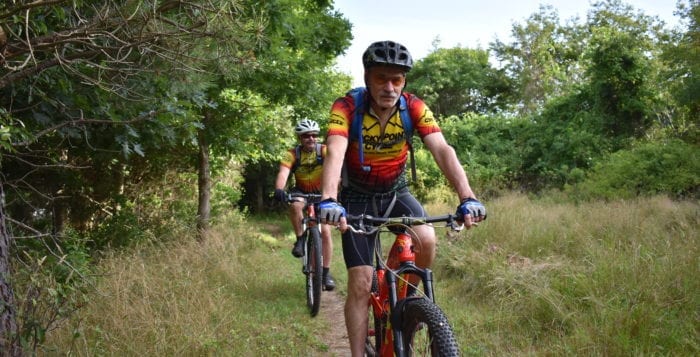With the ever-expanded development along the North Shore of Long Island, it’s easy to underestimate just how many wooded trails and biking paths there are available for those who want to enjoy leisurely outdoor activities off congested roadways.
Trails to check out
Paved paths:
• Nissequogue River Trail 5.1 miles
Nissequogue River State Park, Kings Park
• Kings Park Hike & Bike Trail 1.5 miles
Nissequogue River State Park through Old Dock Road, Kings Park
• The Greenway Trail 3.4 miles
Setauket through Port Jefferson Station
Off-road paths:
• Edgewood Oak Brush Plains
Preserve 5.5 milesCommack Road, Deer Park
Beginner through intermediate
• Calverton Pine Barrens State Forest Loop 7.6 miles
Calverton Pine Barrens State Forest
Beginner through intermediate
• Caumsett Mountain Bike Trail
5.5 milesCaumsett State Park, Lloyd Harbor
Beginner through intermediate
• Sunken Meadow Trail 3.7 miles
Sunken Meadow State Park, Kings Park
Beginner through intermediate
• Rocky Point Mountain Bike Trail
15.2 milesRocky Point State Pine Barrens Preserve
Beginner through expert
• Cathedral Pines Trail 5.7 Miles
Cathedral Pines County Park,
Middle IslandIntermediate
• Meadowland Park Trail 6.0 Miles
Meadowland Park, East Northport
Intermediate
• Glacier Ridge Bike Trail 10.2 Miles
Glacier Ridge Preserve, Farmingville
Beginner through Intermediate
• Overton Trail 3.9 Miles
Overton Preserve, Coram
Intermediate through Expert
• East Setauket Trail 10.5 Miles
Laurel Ridge Setauket Woods Nature
Preserve, East SetauketIntermediate through Expert
“We have so many trails on Long Island — more than 175 miles of them,” said Michael Vitti, the president of the Concerned Long Island Mountain Bicyclists, an organization dedicated to the growth of the activity it’s named for.
County Executive Steve Bellone (D) finally signing the long-awaited bill allocating funds for the Port Jefferson Station to Wading River Rails to Trails project, which will create a 10 mile walking and biking trails along the rights-of-way parallel to the North Shore and north of Route 25A, this might be an opportune time for people to finally put foot to pedal.
Neal Passoff, president of Campus Bicycle in Stony Brook said a prospective biker looking to pick up the hobby should start off riding on paved paths such as the Setauket to Port Jefferson Station Greenway Trail, rather than bumpy terrain.
“There’s still some challenging hills on [the Greenway Trail] but it’s great for people or families starting out that don’t want to worry about traffic,” Passoff said.
Of course, tackling a trail is a tall task without the right kind of bike. While some bikes are able to handle both roads and off-road, bike shop owners said it’s best to buy a bike specific to the style of riding a rider intends on doing. The difference, from the speeds to the shocks to the general design, will dictate how well the bike will perform on the different surfaces.
“People should think of what they plan on doing, not necessarily what they’re doing today, but what they plan on using the bike for,” Passoff said.
Bike shop owners stressed the need for a bike that feels good and fits to a rider’s body rather than forcing a fit. “Get a bike that fits, forget about specific bargains, have one that’s fitted to you,” said Richard Partenfelder, owner of The Cycle Company in Smithtown.
After people get experienced and look to take their bikes off-road they should certainly look for beginner loops in local parks. “Every park has different terrain, and the more difficult trails are located north of the Long Island Expressway, and any trails that are south of the expressway are easier.” Vitti said. “The expressway runs along the glacial moraine, and that makes the north side more hilly.”
Gary Wladyka, the owner of Rocky Point Cycle, said the hardest parts of most trails are how sharp the turns are and the steepness of the trail’s incline.
“For the most part the more difficult trails have more hills that are, to an inexperienced cyclist, something they end up walking up instead of riding up it,” Wladyka said.
He suggested starting on the easy parts of the Rocky Point Mountain Bike and Sunken Meadow trails because they have low inclines without any exceptionally sharp turns.
“Try to keep to the beginner loops because they are relatively flat,” Wladyka said. “They don’t switchback turns, instead they have wider, ‘flowier’ turns.”
In terms of expert trails, both Wladyka and Passoff agreed that some of the hardest to tackle are the East Setauket Trail in Laurel Ridge Nature Preserve and the Overton Trail in the Overton Preserve located in Coram. Those trails have steep hills and sharp switchback turns that can really do a number on a novice biker if they’re not paying attention, they said.
If going into the woods, Vitti suggested people should wear high socks and spray their shoes with permethrin, a tick repellent for clothing.
Some trails are mountain bike only, and some are multiuse trails. Vitti said that while riding on these multiuse paths riders should learn proper etiquette for riding around hikers or other bikers, such as announcing your approach and pulling over to the side so others can pass if they are going in the opposite direction.
For more information about trails and riding etiquette, visit CLIMB’s website at www.climbonline.org.





